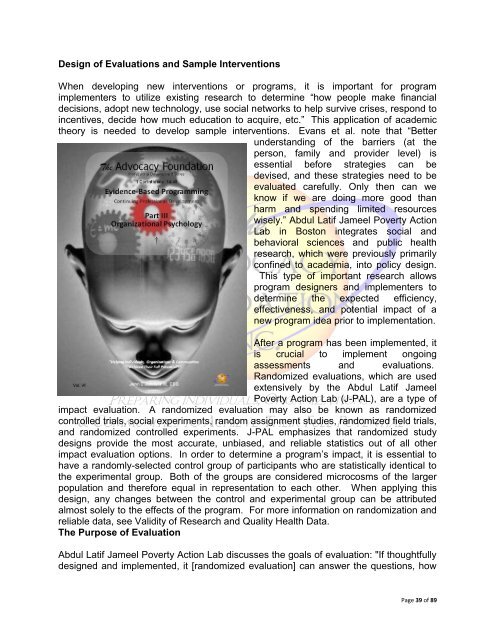The Nonprofit Incubator
The Nonprofit Incubator
The Nonprofit Incubator
Create successful ePaper yourself
Turn your PDF publications into a flip-book with our unique Google optimized e-Paper software.
Design of Evaluations and Sample Interventions<br />
When developing new interventions or programs, it is important for program<br />
implementers to utilize existing research to determine “how people make financial<br />
decisions, adopt new technology, use social networks to help survive crises, respond to<br />
incentives, decide how much education to acquire, etc.” This application of academic<br />
theory is needed to develop sample interventions. Evans et al. note that “Better<br />
understanding of the barriers (at the<br />
person, family and provider level) is<br />
essential before strategies can be<br />
devised, and these strategies need to be<br />
evaluated carefully. Only then can we<br />
know if we are doing more good than<br />
harm and spending limited resources<br />
wisely.” Abdul Latif Jameel Poverty Action<br />
Lab in Boston integrates social and<br />
behavioral sciences and public health<br />
research, which were previously primarily<br />
confined to academia, into policy design.<br />
This type of important research allows<br />
program designers and implementers to<br />
determine the expected efficiency,<br />
effectiveness, and potential impact of a<br />
new program idea prior to implementation.<br />
After a program has been implemented, it<br />
is crucial to implement ongoing<br />
assessments and evaluations.<br />
Randomized evaluations, which are used<br />
extensively by the Abdul Latif Jameel<br />
Poverty Action Lab (J-PAL), are a type of<br />
impact evaluation. A randomized evaluation may also be known as randomized<br />
controlled trials, social experiments, random assignment studies, randomized field trials,<br />
and randomized controlled experiments. J-PAL emphasizes that randomized study<br />
designs provide the most accurate, unbiased, and reliable statistics out of all other<br />
impact evaluation options. In order to determine a program’s impact, it is essential to<br />
have a randomly-selected control group of participants who are statistically identical to<br />
the experimental group. Both of the groups are considered microcosms of the larger<br />
population and therefore equal in representation to each other. When applying this<br />
design, any changes between the control and experimental group can be attributed<br />
almost solely to the effects of the program. For more information on randomization and<br />
reliable data, see Validity of Research and Quality Health Data.<br />
<strong>The</strong> Purpose of Evaluation<br />
Abdul Latif Jameel Poverty Action Lab discusses the goals of evaluation: "If thoughtfully<br />
designed and implemented, it [randomized evaluation] can answer the questions, how<br />
Page 39 of 89

















